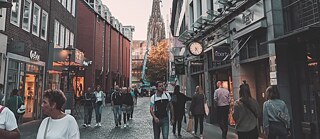Germany’s Oldest School
The secondary school Paulinum Gymnasium was founded in 797 and claims to be the oldest school in Germany. The “schola paulina” was established by the missionary Saint Ludger who had been instructed by Charlemagne to teach Christianity in the “Münsterland.” To this day Münster remains an active center of the Roman-Catholic church.
The New Jerusalem
In 1534 the Anabaptists took power in Münster. They claimed all property, burned all books except the Bible and promoted polygamy in the “New Jerusalem.” The town was recaptured a year later and the Anabaptists were tortured to death. Their corpses were exhibited in cages which can still be seen hanging on the tower of St. Lambert’s church.
Big Brains in a Small Town
With its 280,000 strong population including around 47,000 students, Münster boasts one of the highest “student densities” in Germany. The university is also the city’s largest employer. Almost every fourth person living in Münster either studies, teaches, researches or works at the university. Pope Benedict XVI (then Cardinal Ratzinger) taught theology at Münster University and loved to ride his bike to his lectures.
Thousands of Bikes – But No Helmets!
Münster, Germany’s bicycle capital, is home to an estimated 500,000 bicycles. This means that, from a statistical perspective, each resident owns almost two bikes. Cyclists have access to an extremely well developed, 170-mile network of bike paths. So it’s no wonder that Münster has been voted “Germany’s most bicycle-friendly city” several times, both by the German Automobile Association and the German Cyclists’ Federation.
An Autobahn For Treasure Hunting
The Promenade, a ring of bike paths around the old part of town, is Münster’s bike Autobahn. But don’t get caught riding “hands-free” or you’ll be fined 10 Euros (15 Dollars). On weekends the Promenade is used for one of Europe’s largest open-air flea markets attracting thousands of bargain-hunters and collectors.
Art in the Park
Over a period of 100 days each decade Münster hosts the “Sculpture Projects”, one of the most important international exhibitions of contemporary art displayed in the public sphere. In 2007, the 34 art works by 36 artists from 14 countries attracted around 550,000 visitors from all over the world. The city places several sculptures on permanent display after each exhibition. Münster’s squares and parks have therefore become one large open-air museum.
Crime Pays
Germany's most popular thriller series “Tatort” (Crime Scene) is set in various parts of the country. Each of Germany’s regional TV channels produces its own episodes, starring its own police inspector. The series is broadcast on Sundays at 8:15 pm and Germany’s streets are deserted when the Tatort takes place in Münster. 10 million people can’t wait to find out who did it.
Where Soccer is Not Number One
The soccer club Preußen Münster, runner-up in the German Championships in 1951 and founding member of the Bundesliga in 1963, looks back on a great past while experiencing a rather dismal present. Currently the team lingers in Germany’s 3rd division. More successful are the volleyball ladies from USC Münster who to date have notched up nine German Championship titles and four European Cup victories.
The Münsterland
The flat countryside of the Münsterland boasts quite a number of moated castles and palaces. Being short on hills and mountains on which to build fortresses the local nobility took to digging moats around their castles for protection from marauding enemies. The largest Wasserschloss is the Palace at Nordkirchen, referred to as the ”Westphalian Versailles”.
Move Over, Seattle
In 2004, Münster won an honorable distinction: the LivCom-Award for the most livable city in the world with a population between 200,000 and 750,000. It outshone Seattle and many other better-known cities. The jury chose Münster for its integration of historical heritage into city culture and the promotion of environmental protection.
